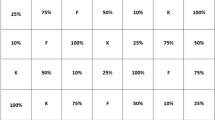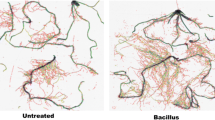Abstract
The ability of western corn rootworm (WCR) (Diabrotica virgifera virgifera LeConte) to develop resistance to various management practices requires the development of new management options. Repellent extracts can act as efficacy enhancing agents in WCR control. The present study investigated the potential repellence of garlic (Allium sativum L.), pepper (Capsicum sp. L), cape aloe (Aloe ferox Mill.), neem (Azadirachta indica A. Juss) and turmeric (Curcuma longa L.) derived extracts against WCR larvae in a no-choice bioassays. In initial screenings garlic and turmeric were evaluated as the most promising extracts as WCR larvae avoided garlic / turmeric treated soil. Turmeric was further evaluated in a rhizotron set up to quantify larval distribution and behavioral changes over time. WCR larvae avoided turmeric treated soil up to 0.05 m from its application in the root system, resulting in an increased dispersal and the formation of multiple clusters in the rhizotron. The proportion of larvae actively moving in the soil subsequently increased, whereas larval feeding significantly decreased. The spatial and behavioral alterations in the soil lead to the conclusion that turmeric is a repellent extract for WCR larvae. Turmeric repellence might further be exploited for WCR management through a synergy with insecticidal substances or microbial antagonists.






Similar content being viewed by others
References
Abbott WS (1987) Abbotts formula - a method of computing the effectiveness of an insecticide. J Am Mosquito Contr 3:302–303
Ball HJ, Weekman GT (1963) Differential resistance of corn rootworms to insecticides in Nebraska and adjoining states. J Econ Entomol 56:553–555
Bergman MK, Tollefson JJ, Hinz PN (1983) Spatial-dispersion of corn rootworm larvae (coleoptera: Chrysomelidae) in Iowa cornfields. Environ Entomol 12:1443–1446
Bernklau EJ, Bjostad LB (1998) Reinvestigation of host location by western corn rootworm larvae (coleoptera: Chrysomelidae): CO2 is the only volatile attractant. J Econ Entomol 91:1331–1340
Bernklau EJ, Bjostad LB (2005) Insecticide enhancement with feeding stimulants in corn for western corn rootworm larvae (coleoptera: Chrysomelidae). J Econ Entomol 98:1150–1156
Bernklau EJ, Hibbard BE, Norton AP, Bjostad LB (2016) Methyl anthranilate as a repellent for western corn rootworm larvae (coleoptera: Chrysomelidae). J Econ Entomol. doi:10.1093/jee/tow090
Boriani MMA, Kiss J, Edwards CR (2006) Sustainable management of the western corn rootworm, Diabrotica virgifera virgifera LeConte (coleoptera: Chrysomelidae), in infested areas: experiences in Italy, Hungary and the USA. Bulletin OEPP/EPPO Bulletin 36:531–537
Branson TF (1976) The selection of a non-diapause strain of Diabrotica virgifera (coleoptera: Chrysomelidae). Entomol Exp Appl 20:148–154
Brown VK, Gange AC (1990) Insect herbivory below ground. Adv Ecol Res 20:1–58
Butt TM (2002) Use of entomogenous fungi for the control of insect pests. In: Esser K, Bennett R (eds) The Mycota. Springer, Berlin, pp. 111–134
Ciosi M, Miller NJ, Kim KS, Giordano R, Estoup A, Guillemaud T (2008) Invasion of Europe by the western corn rootworm, Diabrotica virgifera virgifera: multiple transatlantic introductions with various reductions of genetic diversity. Mol Ecol 17:3614–3627
Clark PL, Vaughn TYT, Meinke LJ, Molina-Ochoa J, Foster JE (2006) Diabrotica virgifera virgifera (coleoptera: Chrysomelidae) larval feeding behavior on transgenic maize (MON 863) and its isoline. J Econ Entomol 99:722–727
Cook SM, Khan ZR, Pickett JA (2007) The use of push-pull strategies in integrated pest management. Annu Rev Entomol 52:375–400
Dethier VG (1956) Repellents. Annu Rev Entomol 1:181–202
Dutilleul P (1993) Modifying the t-test for assessing the correlation between two spatial processes. Biometrics 49:305–314
European Parliament and the Council of the European Union (2009a) Directive 2009/128/EC of the European Parliament and of the council of 21 October 2009 establishing a framework for community action to achieve the sustainable use of pesticides. Off J Eur Union 52:71–86
European Parliament and the Council of the European Union (2009b) Regulation (EC) no 1107/2009 of the European Parliament and of the council of 21 October 2009 concerning the placing of plant protection products on the market and repealing council directives 79/117/EEC and 91/414/EEC. Off J Eur Union 52:1–50
Foster SP, Harris MO (1997) Behavioral manipulation methods for insect pest-management. Annu Rev Entomol 42:123–146
Gassmann AJ, Petzold-Maxwell JL, Keweshan RS, Dunbar MW (2011) Field-evolved resistance to Bt maize by western corn rootworm. PLoS One 6:e22629
Gray ME, Sappington TW, Miller NJ, Moeser J, Bohn MO (2009) Adaptation and invasiveness of western corn rootworm: intensifying research on a worsening pest. Annu Rev Entomol 54:303–321
Hedin PA, Maxwell FG, Jenkins JN (1974) Insect plant attractans, feeding stimulants, repellents, deterrents, and other related factors affecting insect behavior. In: Maxwell FG, Harris FA (eds) Proceedings of the summer institute on biological control of plant and insects and diseases. The University Press of Mississippi, United States of America, pp. 494–527
Hibbard BE, Bjostad LB (1989) Corn semiochemicals and their effects on insecticide efficacy and insecticide repellency toward western corn rootworm larvae (coleoptera: Chrysomelidae). J Econ Entomol 82:773–781
Hibbard BE, Bjostad LB (1990) Isolation of corn semiochemicals attractive and repellent to western corn rootworm larvae. J Chem Ecol 16:3425–3439
Hibbard BE, Duran DP, Ellersieck MR, Ellsbury MM (2003) Post-establishment movement of western corn rootworm larvae (coleoptera: Chrysomelidae) in Central Missouri corn. J Econ Entomol 96:599–608
Isman MB (2006) Botanical insecticides, deterrents, and repellents in modern agriculture and an increasingly regulated world. Annu Rev Entomol 51:45–66
Jilani G, Saxena RC (1990) Repellent and feeding deterrent effects of turmeric oil, sweetflag oil, neem oil, and a neem-based insecticide against lesser grain borer (coleoptera: Bostrychidae). J Econ Entomol 83:629–634
Jilani G, Saxena RC, Rueda BP (1988) Repellent and growth-inhibiting effects of turmeric oil, sweetflag oil, neem oil, and "margosan-o" on red flour beetle (coleoptera: Tenebrionidae). J Econ Entomol 81:1226–1230
Johnson SN, Gregory PJ (2006) Chemically-mediated host-plant location and selection by root-feeding insects. Physiol Entomol 31:1–13
Kahler AL, Olness AE, Sutter GR, Dybing CD, Devine OJ (1985) Root damage by western corn rootworm and nutrient content in maize. Agron J 77:769–774
Kempson D, Lloyd M, Gherardi R (1963) A new extractor for woodland litter. Pedobiologia 3:1–21
Lancashire PD, Bleiholder H, Vandenboom T, Langeluddeke P, Stauss R, Weber E, Witzenberger A (1991) A uniform decimal code for growth-stages of crops and weeds. Ann Appl Biol 119:561–601
LeConte JL (1868) New coleoptera collected on the survey for the extension of the union Pacific railway, E.D. From Kansas to Fort Craig, New Mexico. T Am Entomol Soc 2:49–59
Levine E, Oloumisadeghi H (1991) Management of diabroticite rootworms in corn. Annu Rev Entomol 36:229–255
Lockwood JA, Sparks TC, Story RN (1984) Evolution of insect resistance to insecticides: a reevaluation of the roles of physiology and behavior. Bull Entomol Soc Am 30:41–51
Macdonald PJ, Ellis CR (1990) Survival time of unfed, first-instar western corn rootworm (coleoptera: Chrysomelidae) and the effects of soil type, moisture, and compaction on their mobility on soil. Environ Entomol 19:666–671
Meinke LJ (2008) Western corn rootworm, Diabrotica virgifera virgifera Leconte (coleoptera: Chrysomelidae). In: Capinera JL (ed) Encyclopedia of entomology, 2 edn. Springer Science + Business Media B.V, Leipzig, Germany, pp. 4205–4206
Meinke LJ, Siegfried BD, Wright RJ, Chandler LD (1998) Adult susceptibility of Nebraska western corn rootworm (coleoptera: Chrysomelidae) populations to selected insecticides. J Econ Entomol 91:594–600
Melhus IE, Painter RH, Smith FO (1954) A search for resistance to the injury caused by species of Diabrotica in the corns of Guatemala. Iowa State College J Sci 29:75–94
Metcalf RL (1986) Foreword. In: Krysan JL, Miller TA (eds) Methods for the study of Pest Diabrotica. Springer, New York, US, pp. vii–vxv
Moeser J, Hibbard BE (2005) A synopsis of the nutritional ecology of larvae and adults of Diabrotica virgifera virgifera (LeConte) in the new and old world - nouvelle cuisine for the invasive maize pest Diabrotica virgifera virgifera in europe. In: Vidal S, Kuhlmann U, Edwards CR (eds) Western corn rootworm ecology and management. CABI, London, UK, pp. 41–65
Monke BJ, Mayo ZB, Ball HJ (1985) Bioassay rating system for predicting mortality of moribund corn rootworm (coleoptera: Chrysomelidae) larvae following exposure to insecticide-treated soil. J Econ Entomol 78:467–470
Pereira AE, Wang HC, Zukoff SN, Meinke LJ, French BW, Siegfried BD (2015) Evidence of field-evolved resistance to bifenthrin in western corn rootworm (Diabrotica virgifera virgifera LeConte) populations in western Nebraska and Kansas. PLoS One 10:e0142299
Perry JN (1995a) Spatial analysis by distance indices. J Anim Ecol 64:303–314
Perry JN (1995b) Spatial aspects of animal and plant distribtion in patchy farmland habitats. In: Glen DM, Greaves MP, Anderson HM (eds) Ecology and integrated farming systems. John Wiley & Sons Ltd., Bristol, UK, pp. 221–242
Perry JN (1996) Simulating spatial patterns of counts in agriculture and ecology. Comput Electron Agric 15:93–109
Perry JN (1998) Measures of spatial pattern for counts. Ecology 79:1008–1017
Perry JN, Dixon PM (2002) A new method to measure spatial association for ecological count data. Ecoscience 9:133–141
Perry JN, Bell ED, Smith RH, Woiwod IP (1996) SADIE: software to measure and model spatial pattern. Asp Appl Biol 46:95–102
Perry JN, Winder L, Holland JM, Alston RD (1999) Red-blue plots for detecting clusters in count data. Ecol Lett 2:106–113
Schmutterer H (1990) Properties and potential of natural pesticides from the neem tree, Azadirachta indica. Annu Rev Entomol 35:271–297
Schumann M, Patel A, Vidal S (2013) Evaluation of an attract and kill strategy for western corn rootworm larvae. Appl Soil Ecol 64:178–189
Schumann M, Toepfer S, Vemmer M, Patel A, Kuhlmann U, Vidal S (2014) Field evaluation of an attract and kill strategy against western corn rootworm larvae. J Pest Sci 87:259–271
Smart LE, Blight MM, Pickett JA, Pye BJ (1994) Development of field strategies incorporating semiochemicals for the control of the pea and bean weevil, Sitona lineatus L. Crop Prot 13:127–135
Spike BP, Tollefson JJ (1989) Relationship of plant phenology to corn yield loss resulting from western corn rootworm (coleoptera: Chrysomelidae) larval injury, nitrogen deficiency, and high plant-density. J Econ Entomol 82:226–231
Spike BP, Tollefson JJ (1991) Yield response of corn subjected to western corn rootworm (coleoptera: Chrysomelidae) infestation and lodging. J Econ Entomol 84:1585–1590
Strnad SP, Bergman MK (1987) Distribution and orientation of western corn rootworm (coleoptera: Chrysomelidae) larvae in corn roots. Environ Entomol 16:1193–1198
Strnad SP, Bergman MK, Fulton WC (1986) First-instar western corn rootworm (coleoptera: Chrysomelidae) response to carbon dioxide. Environ Entomol 15:839–842
Su HCF, Horvat R, Jilani G (1982) Isolation, purification, and characterization of insect repellents from Curcuma longa L. J Agric Food Chem 30:290–292
Szalai M, Kiss J, Kover S, Toepfer S (2014) Simulating crop rotation strategies with a spatiotemporal lattice model to improve legislation for the management of the maize pest Diabrotica virgifera virgifera. Agric Syst 124:39–50
Toepfer S, Kuhlmann U (2006) Constructing life-tables for the invasive maize pest Diabrotica virgifera virgifera (coleoptera: Chrysomelidae) in Europe. J Appl Entomol 130:193–205
van Herk WG, Vernon RS (2013) Categorization and numerical assessment of wireworm mobility over time following exposure to bifenthrin. J Pest Sci 86:115–123
Wolf DC, Dao TH, Scott HD, Lavy TL (1989) Influence of sterilization methods on selected soil microbiological, physical, and chemical-properties. J Environ Qual 18:39–44
Acknowledgments
This study was funded by means of the 7th Framework Programme of the European Union 282767 as a part of the project INBIOSOIL (http://inbiosoil.uni-goettingen.de). We would like to thank Bianca Tappe for her technical assistance, Chad Nielson for WCR eggs, and NeemBiotech Laboratory Units (Cardiff, United Kingdom) for providing the botanical extracts. We would also like to thank two anonymous reviewers who helped to improve the manuscript. Mention of trade names or commercial products in this publication is solely for the purpose of providing specific information and does not imply recommendation or endorsement by the U.S. Department of Agriculture. USDA is an equal opportunity provider and employer.
Author information
Authors and Affiliations
Corresponding author
Rights and permissions
About this article
Cite this article
Brandl, M.A., Schumann, M., French, B.W. et al. Screening of Botanical Extracts for Repellence against Western Corn Rootworm Larvae. J Insect Behav 29, 395–414 (2016). https://doi.org/10.1007/s10905-016-9571-3
Revised:
Accepted:
Published:
Issue Date:
DOI: https://doi.org/10.1007/s10905-016-9571-3




